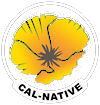
Encelia farinosa
Brittlebush, Desert Encelia

Description
This deciduous mounding shrub typically has gray leaves that can reach 4' tall and wide. However, the leaves will turn white in drought conditions. Bright yellow 1" wide daisies appear in spring and summer. There is rapid growth following rain but this shrub is short-lived. Individual plants will reseed to repopulate. It does well in hot areas but cannot tolerate clay soils due to root rot. It will become overgrown and fragile if overwatered. It will suffer frost damage at 25 degrees F.
Maintenance Tips
Encelia farinosa is a desert shrub that is native to the Southwestern United States, including California. It has a rounded form that grows up to 4’ tall and wide. The foliage is made up of light grey fuzzy leaves and yellow daisy-like flowers that bloom from late winter until summer. It has adapted to live in the desert by going deciduous from summer until late fall when the rain starts again. Around late summer, cut back the loose woody branches hard to about 6”, where it will begin to send out a lush new growth again in the fall.
Plant Type
Shrub
Height Range
3-6'
Flower Color
Yellow
Flower Season
Spring, Summer
Leaf Color
Grey Green, Grey, White
Bark Color
n/a
Fruit Color
n/a
Fruit Season
n/a
Sun
Full, Half
Water
Low
Growth Rate
Moderate
Soil Type
Sandy, Loam, Rocky
Soil Condition
Average, Poor, Well-drained, Dry
Soil pH
Neutral, Basic
Adverse Factors
Attracts Bees
Design Styles
Mediterranean, Ranch, Wild Garden
Accenting Features
Showy Flowers, Unusual Foliage
Seasonal Interest
Spring, Summer
Location Uses
Entry, Shrub Border, Foundation, Parking Strip, Patio, Park, Parking Lot, Raised Planter, Walkways, With Rocks
Special Uses
Container, Erosion Control, Filler, Mass Planting, Fire Resistant, Naturalizing
Attracts Wildlife
n/a
Water Saving Tip:
Water between sunset and sunrise when temperatures and wind are the lowest.